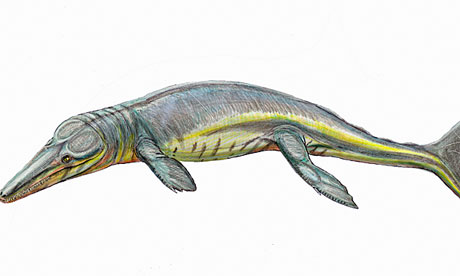Science
Related: About this forumScientists identify crocodile ancestor among fossils discovered a century ago
Source: Press Association
Scientists identify crocodile ancestor among fossils discovered a century ago
Press Association
guardian.co.uk, Monday 28 January 2013 10.03 GMT
A creature resembling a hybrid dolphin and crocodile has been identified by scientists examining fossil remains discovered more than a century ago.
The new species, named Tyrannoneustes lythrodectikos, was a marine "super-predator" that lived 163m years ago. It belonged to a group of ancient crocodiles with dolphin-like features.
An amateur fossil hunter found the reptile's partial skeleton in a clay pit near Peterborough in the early 1900s. Experts have only now been able to confirm the identity of the remains, housed at the Hunterian Museum at the University of Glasgow.
The animal had pointed, serrated teeth and a large gaping jaw suited to feeding on large-bodied prey. It represents a transitional form between marine crocodiles that fed on small prey and their supersized relatives.
[font size=1]-snip-[/font]
Read more: http://www.guardian.co.uk/science/2013/jan/28/scientists-crocodile-ancestor-fossils-century

frogmarch
(12,153 posts)muriel_volestrangler
(101,306 posts)This was also earlier than the mosasaurs - they were in the Cretaceous, while this is Jurassic.
frogmarch
(12,153 posts)some disagreement among scientists as to whether mosasaurs should be included in the order Squamata.
From your Wiki link - Evolutionary antecedents:
The exact phylogenetic position of the clade containing mosasaurids and their closest relatives (aigialosaurids and dolichosaurs) within Squamata remains uncertain. Some cladistic analyses recovered them as the closest relatives of snakes,[31][32]taking into account similarities in jaw and skull anatomies;[31] however, this has been disputed[33][34][35] and the morphological analysis conducted by Conrad (2008) recovered them as varanoids closely related to terrestrial monitor lizards instead.[33]
I’d like to see a scientific paper describing Tyrannoneustus lythrodectikos to see how it's been classified.
muriel_volestrangler
(101,306 posts)There's a link to the paper for Tyrannoneustus in the Guardian article: metriorhynchid
http://www.tandfonline.com/doi/abs/10.1080/14772019.2012.704948?journalCode=tjsp20
It says it's a metriorhynchid, which belonged to Thalattosuchia, which can be seen relative to the Eusuchia, which contains all present-day crocodilians, here:
http://en.wikipedia.org/wiki/Crocodylomorpha#Phylogeny
frogmarch
(12,153 posts)I posted.
Thanks for the links! ![]()